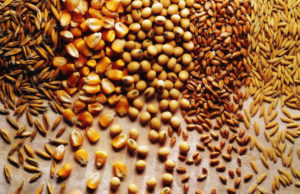 Soybeans fell for a second day on Thursday on speculations that recent gains in prices were overdone amid forecasts for a record-high global output in the 2013-2014 season. Corn and wheat retreated as well.
Soybeans fell for a second day on Thursday on speculations that recent gains in prices were overdone amid forecasts for a record-high global output in the 2013-2014 season. Corn and wheat retreated as well.
On the Chicago Board of Trade, soybeans futures for November settlement slipped 0.99% to $13.3975 per bushel at 12:32 GMT. Prices held in range between days high of $13.6688 per bushel and low at $13.3938 a bushel, the lowest since August 23. Futures slid 2.4% on Wednesday and extended their weekly decline to 1.2% after shedding 0.5% in the preceding five-day period.
Soybeans surged 13% in August, the best monthly performance since July 2012, as dry and hot weather threatened to hurt yields after rains in the beginning of summer delayed crop development which left plants prone to damage from unfavorable weather conditions. Soybeans futures however retreated in the past couple of days as the USDA reported that the crop condition has deteriorated less than expected last week.
The oilseed was further pressured on Thursday as the Agricultural Market Information System set up by G-20 countries reported that global output is expected to advance by 7% in the 2013-2014 season due to higher production in the U.S., Brazil, India and Argentina.
Kona Haque and Chris Gadd, analysts at Macquarie Group Ltd., said that the recent jump in prices is limiting demand and will induce increased planting in South America. “The market has been too willing to price in the most pessimistic views and we would be bearish from current levels in all but the most extreme scenarios,” Haque and Gadd commented.
The USDA reported on Tuesday that as of the week ended September 1, 15% of soybeans were rated very poor-poor, compared to 13% a week earlier and 37% last year. Meanwhile, 31% of the crop was categorized as “Fair”, above the preceding week’s 29% and below 2012′s 33%. As for the premium quality, 44% of the plants were rated as good-excellent, marking a 4% decline from the previous week, but well above last year’s 30%.
Meanwhile, corn futures for December settlement traded at $4.6563 a bushel at 12:33 GMT, down 0.80% on the day. Prices ranged between days high of $4.6913 and low at $4.6538 a bushel, the lowest since August 14. The grain fell 1.3% on Wednesday and extended its weekly decline to 3.6% after falling 2.3% in the previous week.
The USDA reported that the corn crop condition also remained fairly unchanged from last week and well above last year’s quality despite the recent unfavorable weather. As of September 1, 16% of the crop was categorized as “Very poor” and “Poor”, compared to 14% in the preceding week and 52% a year earlier. Meanwhile, 28% of plants fell in the “Fair” category, 1% more than a week earlier and 2% above the same period in 2012. As for the premium quality, 56% of the crop was rated good-excellent, 3% below the previous week and well above last year’s 22%.
According to the Professional Farmers of America, which made a four-day tour of fields in seven Midwest states in the second half of August, soybean output may fall by 3% below USDA’s projections. Soybeans jumped 15% in August as deteriorating weather conditions threatened yields. Meanwhile, corn production might contract by 2.2% below the government agency’s 13.763 billion bushels forecast but it is still expected to be record high.
Elsewhere on the grains market, wheat for December delivery slipped 0.35% to $6.4363 a bushel at 12:27 GMT. Futures held in range between days high and low of $6.4625 and $6.4275 a bushel respectively. The grain marked a minor daily drop of 0.17% on Wednesday, extending its weekly decline to 1.8%.
The U.S. Department of Agriculture reported on Tuesday that as of September 1, 6% of the spring wheat crop was categorized as “Very poor” and “Poor”, 1% less than a week earlier. Meanwhile, 24% of plants fell in the “Fair” category, 2% below the preceding week. As for the premium quality, 70% of the crop was rated good-excellent, marking a 3% improvement from the preceding period.
The agency also reported that harvesting fell behind last year’s pace, but was near the five-year average tempo. As of September 1, 64% of the crop was reaped, compared to the five-year average of 69%. This marked a 22% advance from the preceding week but was well behind last year’s 93% of the crop harvested during the comparable week.





